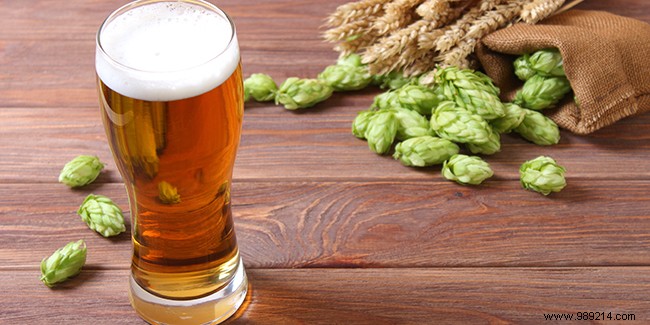Hops generally rhyme with beer, especially in recent years where breweries have been springing up all over France, each offering more or less typical artisanal beers or "craft beer". In addition, this perennial plant allows other uses, particularly culinary, so let's discover its characteristics and benefits.

Credit:Saveur Bière's cooking blog
Hops (Humulus lupulus ) belongs to the Cannabaceae botanical family and looks like a perennial climbing plant that winds around its support in an anti-clockwise direction:we see this vine thus covering trees, hedges, brush or telephone poles in roadside for example.
Its palmately lobed, toothed leaves are deciduous and as the plant is dioecious, the female flowers grow on separate stems from those bearing the male flowers. But it is the cones with greenish-yellow scales constituting the female flowers that are interesting for the production of beer:they still give the slight taste of bitterness to beer today, but the first cultures of hops in a German monastery in the year 859 were also used to better preserve the beverage.
Over the centuries, hops also proved to be endowed with interesting therapeutic properties, yet it was not until the beginning of the 19th century that the active principles of the plant were not scientifically studied.
Once dried, the cones do not smell very good and have a very bitter flavor, they are used in herbal tea for their tonic, analgesic, stomachic, sedative, anaphrodisiac properties, mainly. In addition, the essential oil of hops used in massage will help you fall asleep or calm a painful area.
Cooking with beer is a tradition mainly from the north of France, England, Flanders (Belgium) and Germany, with some emblematic dishes such as carbonnade flamande or welsh from Wales, but it also serves as an essential drink (to be consumed in moderation) to accompany sauerkraut or mussels and fries.
It is incorporated in small doses in the recipe for waffles, donuts and pancakes, in order to make the dough lighter and the delicacies softer due to the yeasts contained in the drink.
Beer can also flavor the kitchen, whether meat or fish, depending on whether you choose a lager, white, dark, amber, spicy, sweet, tart, bitter, etc.
But besides the beer in which hops appear as an ingredient, the young shoots of hops themselves can be eaten and cooked raw or cooked. Moreover, some starred chefs have tried it successfully, such as Jessica Préalpato, pastry chef at the three-star Plaza Athénée restaurant in Paris, who became "best pastry chef in the world 2019", creator of a galette with hops, caramelized barley, iced beer ! Other cooks don't hesitate to combine hop shoots with morels or truffles, but more simply, a country omelette cooked with these young shoots of hops will delight you…provided you can find them! Indeed, these shoots from the rhizome of hops, which point their nose around February-March, are rare and difficult to find because the "season" is short. Fortunately, their bitterness is such that there is no need to have a lot on the plate.